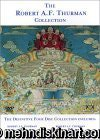 |
|
|
 | Heinrich
Harrer, there's a good chance this lavish $70 million film would not have
been made. It was one of two films from 1997 (the other being Martin
Scorsese's exquisite Kundun) to view the turmoil between China and Tibet
through the eyes of the young Dalai Lama. But with Brad Pitt onboard, this
adaptation of Harrer's acclaimed book focuses more on Harrer, a Nazi party
member whose life was changed by his experiences in Tibet with the Dalai
Lama. Having survived a treacherous climb on the challenging peak of Nanga
Parbat and a stint in a British POW camp, Harrer and climbing guide Peter
Aufschnaiter (nicely played by David Thewlis) arrive at the Tibetan city of
Lhasa, where the 14-year-old Dalai Lama lives as ruler of Tibet. Their stay
is longer than either could have expected (the "seven years" of the title),
and their lives are forever transformed by their proximity to the Tibetan
leader and the peaceful ways of the Buddhist people. China looms over the
land as a constant invasive threat, but Seven Years in Tibet is more
concerned with viewing Tibetan history through the eyes of a visitor. The
film is filled with stunning images and delightful moments of discovery and
soothing, lighthearted spirituality, and although he is somewhat miscast,
Brad Pitt brings the requisite integrity to his central role. What's missing here
is a greater understanding of the young Dalai Lama and the culture of Tibet.
Whereas Kundun tells its story purely from the Dalai Lama's point of view,
Seven Years in Tibet is essentially an outsider's tale. The result is the
feeling that only part of the story's been told here--or maybe just the
wrong story. But Harrer's memoir is moving and heartfelt, and director
Jean-Jacques Annaud has effectively captured both sincerity and splendor in
this flawed but worthwhile film. --Jeff Shannon
Read more |
|

| Ten
years in the making, this award-winning documentary was filmed during a
remarkable nine journeys throughout Tibet, India and Nepal. CRY OF THE SNOW
LION brings audiences to the long-forbidden "rooftop of the world" with an
unprecedented richness of imagery… from rarely-seen rituals in remote
monasteries, to horse races with Khamba warriors; from brothels and slums in
the holy city of Lhasa, to the magnificent Himalayan peaks still traveled by
nomadic yak caravans. The dark secrets of Tibet’s recent past are powerfully
chronicled through riveting personal stories and interviews, and a
collection of undercover and archival images never before assembled in one
film. A definitive exploration of a legendary subject, TIBET: CRY OF THE
SNOW LION is an epic story of courage and compassion.
Read more |
|

|
Together with some of the
greatest peacemakers of our time, a young filmmaker searches for the truth
about Tibet's Panchen Lama, a boy whose fate could affect the destiny of a
country struggling to avoid the destruction of its spiritual traditions. |
|

| This
54-minute introduction to Tibet has some pretty pictures but is lacking the
strong story line needed to maintain interest. The focus on barley and
Tibet's dependency on yaks seems like an odd starting point considering the
country's tragic history. Tibet has been illegally occupied by China since
their invasion in 1949 and His Holiness the Dalai Lama was forced into exile
in 1959. This is noted as a written prologue but it is not until the latter
part of the video that it is covered. Certainly China's effect on Tibet's
ecosystem is worth documenting, and this is where William Bacon, described
as a three time Emmy Award-winning cinematographer but credited on Tibet: On
the Edge of Change as a producer, seems most comfortable. Strip mining,
clear cutting, and nuclear waste are among the problems facing modern-day
Tibet; however, viewers unfamiliar with Tibet will yearn for context and
organization. Other options for learning about Tibet's unique and complex
culture that inextricably links the Dalai Lama with Tibetans and their land
would include Martin Scorsese's Kundun and the book My Land and My People:
The Original Autobiography of His Holiness the Dalai Lama of Tibet. Music
that evokes Tibet's Himalayas includes Yungchen Lhamo's Coming Home and the
Gyoto Monks' Freedom Chants from the Roof of the World. --Cristina Del Sesto
Read more |
|

| A Dann
Moss Production with Windham Hill Productions, Inc. Original Score by Mark
Isham. Mere mention of the word Tibet evokes images of a rich and magical
country, its culture shrouded by a remote and inaccessible location. This
program provides a look at the place called the "Roof of the World", a place
where the heavens and the earth meet, and where centuries old rhythms
continue. It is a brief of vast stretches of empty, high plains and
snow-capped peaks. The monasteries and the monks who live there are the last
of an ever diminishing religious culture which has no parallel in the West.
5.1 Remix from original multi-tracks by Mark Isham. Audio commentary from
Mark Isham
Read more |
|

| "Heart
of Tibet" is a beautiful biography of the life of His Holiness Tenzin
Gyatso, the 14th Dalai Lama of Tibet. We see the young Dalai Lama emerge
from the secluded life as the spiritual and temporal head of Tibet to a
world leader known for his compassion & non-violence (despite his having
been exiled from his homeland). Through interviews with H.H. the Dalai Lama
& others, we catch a glimpse of the remarkable person who inspires all those
around him. Throughout the video we encounter the Dalai Lama as he arrives
in the States to perform a Kalachakra ceremony & learn a few of the basic
principles of Tibetan Buddhism along the way. Just try to watch him without
breaking into a big grin... I dare you. Read more |
|

| Tibet,
which has always been isolated by being located high in the Himalayas, is
visited in this documentary by an Indian mountain climber who was part of a
team that once climbed Mt. Everest. Approaching Tibet by way of the highest
road on earth, the caravan of jeeps passes through scenery that is both
forbidding and spectacular. Along the side of the road, a Buddhist pilgrim
does full-body prostrations as he slowly makes his way toward a holy site.
The unique nature of Tibet, where a society based on Buddhist concepts of
compassion and devotion flourished for centuries, is illustrated by vintage
films shot by visitors decades before the Chinese invasion of the 1950s. The
narration cogently notes that the old color films of Buddhist pageants
conducted in Lhasa, depicting hundreds of colorfully attired monks and
pilgrims, are the last look at an ancient society. The footage shot in the
1980s, when the Chinese had relaxed the borders of Tibet and allowed
westerners to film, including scenes of the Potala Palace in Lhasa, the
traditional home of the Dalai Lama, is often fascinating. But contrast
across the decades shows modern Tibet to be a deeply troubled land under
Chinese rule, with its ancient culture and traditions slowly being erased.
--Robert J. McNamara
Read more |
|

| Explore
the history and culture of Tibet, from its ancient past to modern times,
with Robert A. F. Thurman, Tibetan scholar, writer and translator, and a good
friend of the Dalai Lama. Time Magazine, which chose him as one of its 25
most influential Americans, described him as a "larger than life
scholar-activist destined to convey the Dharma, the precious teachings of
Siddhartha, from Asia to America." In this three-part series, Thurman tells
us, with humor and insight, the stories and legends of the ancient Tibetan
kings, heroes, sages, saints, and adepts. We see how the Dharma progressed
in Tibet and how a powerful renaissance spirit seized the nation and a life
dedicated to evolutionary progress towards Buddha hood became the prevalent
model for Tibetans. 240 minutes.
Read more |
|

|
Explore the history and culture of Tibet, from its ancient past to modern
times, with Robert A. F. Thurman, Tibetan scholar, writer and translator, and
a good friend of the Dalai Lama. Time Magazine, which chose him as one of
its 25 most influential Americans, described him as a "larger than life
scholar-activist destined to convey the Dharma, the precious teachings of
Siddhartha, from Asia to America." |
|

| Midway
through Sarah Pirozek's concert documentary, Free Tibet, about the 1997
two-day benefit show in San Francisco, Smashing Pumpkin guitarist James Iha
clearly summarizes the proceedings. "It's hard to expect real serious
intentions with a rock concert with millions of kids." Indeed. Most of the
thousands in attendance over the weekend didn't know squat, much less care,
about the situation in Tibet. As long as they got to see Rage Against the
Machine hammer home their political fury or A Tribe Called Quest kick out
the jams, everything would be fine. This documentary, which mixes concert
footage with backstage and crowd interviews, political lectures, and
archival footage of Tibet's downtrodden history, successfully captures both
the good intentions of the festival organizers and the ignorant audience
reception, i.e., kids more interested in moshing and partying than world
peace. As one kids puts it, "I care, ya know, but short attention span." The
same unfortunately can be said of Pirozek's approach to all of this. She
directs the film like she has ants in her pants, and then cuts it together
with a blender. If you want the film to catch live moments by your favorite
bands, you'll be disappointed. Pirozek rarely keeps the camera onstage long
enough to enjoy the bands. Only Bjork's mesmerizing performance of
"Hyper-Ballad" and Sonic Youth's "Bull in the Heather" are played in their
entirety; otherwise, bands are interrupted by interviews, speeches, and
random bits of Tibetan history. While it's admirable for the documentary to
teach its audience along with entertaining with music, its approach is
halfhearted on both accounts. --Dave McCoy Read more |
|

| " It has
endured for centuries as a vision of perfection on earth a mythical valley
where a race of immortal humans live in total harmony. From ancient myths to
the recent bestseller Lost Horizon, Shangri-La has fascinated us for ages.
TIBET'S LOST PARADISE unravels the true history of this appealing myth and
seeks out the legendary home of this earth-bound utopia. Travel to remote
valleys of China, Nepal and Tibet, where local folklore insists that such a
place exists. Trace the origins of the enchanting tale with the world's
leading experts, who reveal how this Eastern vision was embraced by the
Western World. Finally, venture high into the Himalayas, where Indian
tradition holds that ""perfect men"" still live. Journey to the ends of the
earth to find out if there is any truth to the captivating fable of
Shangri-La."
Read more |
|

| This
2003 DVD release, "Mount Kailash, Return to Tibet", contains two complete
documentaries. The title documentary follows 71 year old flutist, Paul Horn,
on a pilgrimage to the 32 mile Kora trail, which circles the base of sacred
Mount Kailash. Also included on this disc is 1998's PBS feature, "Journey
Inside Tibet", which follows Paul Horn and his traveling companion, Lama
Tenzin. For "Journey Inside Tibet", Paul Horn's goal was to play his flute
inside Tibet's Potala Palace, while Lama Tenzin's goal was to visit his
homeland and see his family there. Despite the title of the DVD, for the best comprehension of both works, the viewer should watch "Journey Inside Tibet" first, then follow it with another session dedicated to the viewing of the title piece. "Journey Inside Tibet" begins in Kathmandu, Nepal at a Tibetan refugee camp. Here we see work being done at a local carpet making factory. Next, footage of the colorful Ka-Nying Shedrupling Monastery is shown, where the pilgrims make audio and video recordings of it's ceremonies. Documentation of a difficult 520 mile bus trip, along the friendship highway, follows. The travelers stop occasionally while on their way, to observe the life of the rural peoples. After some 30 minutes into the documentary, the travelers reach their destination, Lhasa. They start their visit at the Tashihunpo Monastery, founded by the first Dalai Lama. It is here that Lama Tenzin meets his family. Then, on to the Jokhang Temple and Potala Palace where Paul Horn plays his flute. In the years between the making of the two documentaries, Lama Tenzin dies, so with "Mount Kailash, Return to Tibet" there are again two goals. Paul Horn's spiritual pilgrimage to the mountain. Also, the dispersal of Lama Tenzin's ashes at the Kora trail's summit. Again, the difficult traveling conditions of a 1000 mile journey are documented, along with the sights and sounds of the local peoples. The focus, with "Mount Kailash", is primarily on the Tibetan natural world. Both documentaries are accompanied by engaging soundtracks. These were recorded after each trip was completed, but were based on sounds acquired while in Tibet. These sounds were then supplemented with studio overdubbing and sonic layering techniques. This DVD can be recommended, with confidence, to those with an interest in Buddhism or spiritually centered music. Read more |
|

| "Tibetan
Medicine" is a thirty-minute video that consists of documentary film footage
of Tibetan refugees living in the Indian Himalayas. The specific focus is on
an area surrounding the center for Tibetan Medicine there. The film features
the practices of the center itself and also shows some of the activity that
supports its operation. There is wonderful cinematography of the gathering
of both plants and minerals for medicines, as well as documentation of the
work of medicinal preparation through the use of hand tools and machines. In "Tibetan Medicine", humans are known as both a physical entity and as a metaphysical potentiality. The doctors are trained to aspire to four meritorious qualities: I) To be motivated by an altruistic mind, II) To be industrious and energetic, III) To abstain from intoxicants, IV) To be mindful of the work at hand and to make the patient feel both relieved and assured. Medical students are shown chanting ancient medical texts as an aid to their memorization and also as a spiritual practice with the aim of achieving the ends described above. The film attributes the origin of sickness to be of two main causes: I) 'Ignorance' or the inability to perceive reality due to the loss of psychological equanimity. II) 'Immediate Causes' such as improper diet or the influence of a range of visible and invisible forces. It shows diagnosis of sickness through what appears to be the feeling of a patient's pulse, but the narrator suggests that their is a psychic component of this practice as well, which may be difficult to prove through western science alone. The doctor states that it took her some twenty years to master such a diagnostic technique. Healing at the center takes place through acupuncture, moxibustion[ a burning of herbal mixtures attached to the skin ], or the ingestion of a variety of medicines. Surgery is rarely performed. A week's supply of medicine generally costs only fifty cents and their is no cost for the doctor's diagnosis, which is subsidized by the Dalai Lama and the Indian Government. This film may perhaps best serve as an anthropological introduction to the ways of Tibetan medical practice. Interested parties may also want to view Franz Reichle's "The Knowledge of Healing", which begins to give detail on a modern western scientific analysis of the ancient Tibetan practices. Read more |
|




